This September and October, we’re taking a look at the 1995 to 1996 season of Star Trek, including Star Trek: Deep Space Nine and Star Trek: Voyager. Check back daily for the latest review.
In what is becoming a recurring theme for the second season of Star Trek: Voyager, Prototype is a mess.
As with a lot of the surrounding episodes, its production was fraught and tense; tensions seemed to be building among the production team as the season progressed. Prototype was an episode that was largely driven by Michael Piller, and one opposed by Jeri Taylor. Kenneth Biller was responsible for tweaking and rewriting Nicholas Corea’s script, but he does not seem particularly fond of the episode. These tensions and disagreements would build to a climax in the second half of the year.
Prototype is not a good episode, by any measure. There are a lot of elements that are interesting on their own terms, but there is also something quite nasty and uncomfortable sitting at the heart of the hour. It is a story about motherhood, but one which suggests that unconventional motherhood must be monstrous and grotesque. Even beyond the awkward subtext of the episode, there are problems. Despite Piller’s attempts to energise storytelling on Voyager, the pacing of Prototype is atrocious.
Prototype is not the biggest misfire of the season. Given the season around it, this should not be misconstrued as an endorsement.
There is something decidedly old school and pulpy about Prototype. One of the more interesting aspects of the first two seasons of Voyager is the way that the show constantly and repeatedly harks back to the classic Star Trek aesthetic. Caretaker worked very hard to establish Voyager as a return to the “space western” template of classic Star Trek, right down to creating a Native American first officer and creating the Kazon as (misguided) space!Indians. Time and Again was a warning about nuclear power shot in primary colours.
The first two seasons of Voyager have a very weird style to them, one that seems consciously out of place against the backdrop of nineties television. Some of the science-fiction concepts driving early episodes of Voyager would seem too outlandish for Star Trek: The Next Generation or Star Trek: Deep Space Nine. It seemed like the show was always pulling the crew apart (Faces) or putting them together (Tuvix). Stories like The Thaw and Innocence are concepts with which William Shatner would seem more comfortable than Patrick Stewart or Avery Brooks.
So, with all of that in mind, Prototype is an episode that feels like it would have made for a perfectly middling episode of classic Star Trek. It has that same fear of artificial intelligence that drove episodes like What Are Little Girls Made Of? and The Ultimate Computer. The central story is a metaphor for the dangers of a perpetual arms race, reflecting episodes like The Doomsday Machine. If anything, the story seems much less relevant against the relative peace and prosperity of the nineties than it would have in the sixties.
However, there is more to it than that. The episode’s aesthetics feel weirdly out of step with nineties Star Trek. The design of the Pralor and Cravic robots are consciously retro, with the episode covering performers in lots of plates and casts so as to simulate a robotic design. The creatures look like they escaped from some strange fifties or sixties b-movie airing on late-night cable. They certainly look quite different from what some have described as that “forehead of the week” approach to nineties Star Trek aliens, looking more like something from Doctor Who.
In an interview with Cinefantastique, writer and producer Kenneth Biller was openly critical of the design of the episode’s robotic characters:
But it was a really disappointing episode in the sense that exactly what we feared happened: the robot looked like a guy in the suit. It just looked really, really hokey and cheesy. That was an almost impossible task given what our budgetary constraints are and given the time that is allotted. We couldn’t afford to do body makeup so suddenly he’s in costume. If he is a mechanical man, why is he wearing a suit?
Nineties Star Trek worked very hard to be taken seriously as prime time television. There was a clear resistance to some of the goofier (or pulpier) science-fiction trappings.
However, the design of the robots is not a problem with the episode. The design might look a little ridiculous, but it seems arbitrary to complain about Star Trek aliens looking ridiculous when designs like the Klingons and the Ferengi have become a staple of the franchise. If anything, the robots are a breath of fresh air. Compared to a lot of the one-shot aliens to appear on Voyager, their design is unique and distinctive. They are, perhaps, the most memorable aspect of Prototype.
There are lots of nice touches about the robots, once the viewer gets past the fact that they look more like the Cybermen than the Borg. Their expressionless faces are uncanny and unsettling; the little dents and imperfections in the faces of various individual robots suggest the wear and tear of an eternity spent at war without any means to properly repair or to build replacements. (In fact, it could be argued that Voyager itself could use a sensibility like that.)
More than that, the fifties or sixties design feels entirely appropriate for the episode in question. Prototype is basically written as an allegory about mutually assured destruction, the fear that warring civilisations might come to manufacture weapons that will destroy all life. The robots at the heart of Prototype are still waging a war that began long ago and that will continue into perpetuity long after all the combatants are deceased. It is quite similar to the fate of Bele and Lokai in Let That Be Your Last Battlefield.
It is a metaphor that seems more suited to the mood and tone of the sixties. The idea of two states locked in a conflict that could burn long after they have faded into history is very much a Cold War concern, reflecting anxieties about rapidly-expanded nuclear arsenals. It feels slightly less appropriate in the context of “the unipolar moment”, the point at which the United States had vanquished the Union of Soviet Socialist Republics and seemed to stand as victor at what some preemptively described as “the end of history.” In that context, b-movie robots feel appropriate.
That said, there is a way that Prototype could reflect nineties fears and uncertainties. The robots are a monstrous force that awoke during a time of massive conflict, but refused to let themselves become obsolete as times changed around them. “If both sides called a truce, then why didn’t they stop you from fighting?” Torres demands when 3947 reveals that the war was over. “They attempted to do so,” 3947 explains. When their creators attempted to render them redundant, the warriors resisted, “We terminated the builders.”
3947 explains the cold logic employed by the machines. “When it was anticipated that the war would end, the Builders no longer required our services and they intended to terminate us. In doing so, they became the enemy. We are programmed to destroy the enemy. It is necessary for our survival.” These robots were built to wage war; any attempt to prevent them from waging war is an attempt to deny their function and purpose; it is an attack up their identity that must be met with a forceful response.
As such, the warring robots could be seen as an embodiment of the worst excesses of the American military-industrial complex. They are warriors who will not allow themselves to be retired or to become unnecessary. It has been argued that the end of the Cold War only encouraged certain military tendencies. As Andrew J. Bacevich argues in The New American Militarism:
Our own day has seen the revival of Wilsonian ambitions and Wilsonian uncertainty, this time, however, combined with a pronounced affinity for the sword. With the end of the Cold War, the constraints that once held American ideologues in check fell away. Meanwhile, in more than a few quarters, America’s unprecedented military ascendancy, a by-product of victory in the Cold War, raised the alluring prospect that here at last was the instrument that would enable the United States to fulfill its providential mission.
As much as the nineties were defined by relative peace and prosperity for the United States, they did feature an expansion of the private military sector and a number of major international engagements for United States armed forces. (It could even be argued that militarisation took root domestically, with many police departments becoming increasingly militarised during the decade.)
However, Prototype lacks the depth necessary for a metaphor like this to really work. Instead, Prototype plays as a tired update of The Doomsday Machine, an allegory quite irrelevant to the world in which it aired. One of the legitimate criticisms that might be made of Voyager is the fact that it seemed to grow increasingly disconnected from the world around it; the ship might have been lost and adrift in the Delta Quadrant, but the show was growing ever more out of touch with the present day.
This is most obviously related in the difficulties that Voyager had pushing the Star Trek franchise forward, resting comfortably within a template established by The Next Generation. It seemed like Voyager was wilfully oblivious of the changes taking place around it as part of the wider television landscape. More than that, though, it seemed like Voyager was out of touch with the world beyond the television screen; that the series was not engaging with contemporary America in the way that The Next Generation had.
Voyager managed a handful of “Star Trek as allegory” stories, but they frequently seemed quite removed from a larger cultural context. Jetrel was about the dropping of the atomic bomb, Prototype is about mutually assured destruction, Remember is about the holocaust. Then again, given that the Kazon were created as an attempt to engage with the issue of gangs in contemporary Los Angeles, it might not be such a bad thing that Voyager drifted away from modern-day allegories.
Even the parts of Prototype that are not related to mutually assured destruction feel strangely academic and disconnected. There is a long scene about half-way through the episode where Janeway and Torres talk at length about the heavy moral decision weighing upon them. Torres wants to teach the robots how to design new units; Janeway is reluctant to do so. Janeway argues that this would violate the Prime Directive, despite the fact that Janeway would heavily violate the Prime Directive in the very next episode.
The problem with the extended dialogue-driven scene is that it is all completely abstract and unrelatable. Torres and Janeway are arguing about something for which the viewer has absolutely no frame of reference. “Unlike a species whose become sterile, the robots never had the ability to reproduce,” Janeway tells Torres. “What you’re talking about is giving them new abilities, which is the equivalent of altering their genetic structure.” It is the kind of theoretical and abstract discussion of the Prime Directive one expects of internet message boards, not the show itself.
If viewers are to invest in these sorts of earnest moral conversations, there needs to be stakes that we understand and care about. Maybe if the script gave us a better sense of Torres’ emotional investment in this particular story, it might work. Maybe if the robots were stand-ins for a morally-complicated issue that the show could explore obliquely, the audience would care. Instead, the entire sequence plays as an abstract conversation about the application of a fictional principle for the sake of having an abstract conversation about the application of a fictional principle.
It doesn’t help matter that Janeway’s interpretation of the Prime Directive is very much on autopilot. Janeway and Torres are essentially walking through an extended conversation vindicating the “God does not want them to live” interpretation of the Prime Directive. “Unfortunately extinction is often the natural end of evolution,” Janeway remarks; it seems like she’d get along great with Phlox. Torres responds, “So you’re just willing to let their entire society die off?” The episode seems curiously okay with this.
Of course, the reason that the episode is curiously okay with this is because the “society” in question is composed entirely of robots. Prototype harks back to the classic Star Trek in more than just its choice of allegory and its aesthetic sensibilities. There is also a very pronounced anxiety about artificial intelligence. For all that the Star Trek franchise is science-fiction, it seems quite terrified of certain lines of scientific thought. Subjects like cloning and artificial intelligence (and genetic engineering) tend to prompt knee-jerk horror from the franchise.
There are exceptions, of course. Torres tells 3947 about Data, which really seems like the script is trying to say “some of my best friends are robots, really.” The acknowledgement of Data does not prevent Prototype from playing into the same uncertainties and anxieties that marked scripts like The Return of the Archons or The Apple. It seems like artificial life is just inherently unnatural; that acknowledging the basic right of reproduction of life forms that are not biological in nature is grotesque. This is not Star Trek at its most open-minded and optimistic, by any measure.
This becomes a problem when considered in light of the other big theme of Prototype. Much is made of the idea that Torres is a surrogate mother to these robot figures. Tellingly, the robots are all clearly defined as masculine; their physiques are recognisably male by human standards, and they are played by male actors. There is a rather uncomfortable reading to all this, as Torres must learn that she cannot help a bunch of men conceive life in an unconventional fashion. (The horror of the realisation is underscored by the script. “My God, what have I done?”)
The Star Trek franchise has never been particular good at handling issues around sexual orientation or sexuality. The production team often seemed blind to the existence of people who were not conventional heterosexual individuals. It seems likely that gay panic subtext of Prototype is completely unconscious, the result of the production team failing to consider the implications of building an episode about a species who cannot reproduce played by an all-male cast.
Understandably, Frankenstein is very much a touchstone for Prototype. It is a story about the futility and horror of trying to create “unnatural” life. As such, the episode opens itself to any number of uncomfortable readings, playing as a horror story about gay parenting or surrogacy or even single mothers. Prototype is essentially a story about how there is a right way and a wrong way to bring new life into the world, and one that seems quite insistent that the wrong way is any way that does not involve a male and female biological parent in a conventional relationship.
This becomes a little uncomfortable when the story is examined through the lens of B’Elanna Torres. Interviewed by Cinefantastique, actress Roxann Biggs-Dawson explained that the story was essentially about Torres becoming a mother:
So much of Prototype was the only way B’Elanna could deal with her own mothering instincts and creation [instincts]. At this point in her development, probably the only way that she can confront her feelings and herself, is through the creation and adoption of a mechanical being, of a robot, and to be as excited about that as some people [are] about children or other kinds of creation.
This is certainly an interesting way of looking at Prototype, not least in the context of B’Elanna Torres’ character development over the remaining five years of the show. Given the premise of Voyager, it makes sense that the crew might want to start families; Paris and Torres come to form perhaps the show’s strongest couple.
Prototype is quite explicit in its portrayal of “Torres as unnatural mother figure.” Even before she is abducted and forced to design a new robot power source, Prototype suggests that Torres has maternal feelings towards 3947. She warns him to be careful before he returns home. “You are repeating instructions you have already given me,” 3947 remarks, identifying Torres as a fretting mother. “I’m just making sure,” she replies. Later she asks, “Are you going to be the obstetrician of this unit, 3947?” When it works, she identifies 3947 as the prototype’s “father.”
The closing scene between Torres and Janeway underscores this maternal theme running through the episode. “It was no small achievement, B’Elanna,” Janeway tells her. “You gave that unit life.” Just in case the audience does not get the metaphor, Torres pushes the idea further. “You should have seen it, Captain,” she urges. “It was incredible. I installed that module, and the prototype looked up at me and asked me for programming.” The script makes it quite clear that Torres essentially made a baby, albeit a robotic six-foot-tall baby.
Voyager is the Star Trek show with the largest number of female characters among its primary cast. (The Next Generation had the same number, but one of those female cast members was killed off towards the end of the first season.) Voyager is also the only Star Trek show with a female lead actor. As such, it is occasionally important to examine the show from the perspective or gender and sexuality. It is interesting how much emphasis the show puts on motherhood during the opening couple of seasons.
Janeway has a recurring holodeck fantasy of playing governess to two young children; in Persistence of Vision, Janeway is attacked by one of the children who claims that she is attempting to usurp the role of mother in the holographic family unit. Kes found herself facing her own maternal crisis in Elogium, when the anomaly of the week prematurely triggered her reproductive impulses and capabilities. Torres is essentially “mother” to two threats to the ship in Prototype and Dreadnought.
It doesn’t help matters that two of the second season’s most prominent recurring characters are defined as mothers. Elogium revealed that Samantha Wildman is pregnant, and she will eventually give birth to a baby girl in Deadlock. Seska suddenly became baby obsessed in Manoeuvres and will have her own child in Basics, Part I. The second season of Voyager spends a considerable amount of time defining its major female characters as mothers, much more than The Next Generation or Deep Space Nine did. (Of course, Beverly Crusher actually was a mother.)
To be fair, the show does occasionally challenge the male characters with similar issues. Tuvok has left his family on Vulcan; Ayala has children in the Alpha Quadrant; Elogium is as much about whether Neelix is ready to be a father as it is about whether Kes is ready to be a mother; Parturition finds Paris and Neelix playing at being parents on a hostile planet; Real Life has the EMH building himself a simulation of a holographic family. Nevertheless, it seems like parenthood is not as pressing a concern for the show’s male characters on a week-to-week basis.
In the specific case of Torres, there is something quite unsettling about the fact that both Prototype and Dreadnought find the engineer’s “unnatural” offspring posing a very real threat to the ship. There is something quite reactionary about all of this, as if to suggest that Torres’ career as an engineer is somehow just a perversion of her maternal instincts; that Torres (and the universe) might be a lot happier if Torres simply created life the old-fashioned way rather than designing it in a professional capacity.
Even leaving aside the uncomfortable subtext of Prototype, the script itself is a mess. The pacing is terrible; the episode is half-way through before anything actually happens. The first act drags as Torres tries to figure out the right technobabble to awaken 3947; the second act gets bogged down in a long and pointless Prime Directive discussion that is so abstract as to be meaningless. Michael Piller had argued that Voyager scripts needed to get faster to keep up with contemporary television; watching Prototype, it is hard to disagree too heartily.
(That said, it is worth noting that Piller seemed to be full of good ideas about how best to improve Voyager. While these ideas worked quite well on paper, the show had a lot of difficulty translated them into measurable improvements in the quality of the series. After all, the big argument that Piller had about the pacing of Voyager took place during the production of Tattoo; there is absolutely no context in which Tattoo should be held up as an aspirational object.)
Of course, Prototype was an episode which caused considerable friction among the Voyager production team. Increasingly, it seemed like Michael Piller and Jeri Taylor were at odds about how Voyager should work. Piller was aggressively pushing for more “out there” stories, while Taylor was advocating more caution and conservatism. On paper, Piller makes a convincing case; however, the producer’s boundless ambition is also responsible for some of the biggest missteps of the entire season.
In Captain’s Logs Supplemental, Piller recalls the response of the other producers to the pitch for Prototype:
Frankly, Jeri [Taylor] was not enamored with this story, and both she and Rick [Berman] were very concerned that we were not going to be able to pull off a robot, so I ended up as the one saying, ‘Guys, this is Star Trek! You’re going to tell me we can’t do robots? They can do robots on Outer Limits, but the top science-fiction franchise on television can’t do robots?’ So finally they sort of grumbled and went along with me on this.
It doesn’t seem like Piller got a lot of support in trying to make Prototype work.
Indeed, there are elements of Prototype that do mark it as a product of late-stage Piller. Most notably, there is a weird confrontation between Chakotay and Paris that seems to come out of nowhere and disappears almost as quick. In the middle of a delicate and high-stakes rescue mission, the two characters pause to trade barbs. “You don’t mind if the rest of us give you a little help, do you, Paris?” Chakotay taunts. “I’d hate to lose another shuttle.” Paris replies, “Your concern for my welfare is heartwarming.”
It is a weird exchange on a number of levels. Most obviously, it is horrible written. It is the most stock way of showing tension between two characters, with belaboured snark and sarcasm at a point when everybody should be focused on more important things. The delivery doesn’t really help, either; Robert Beltran was never the most emotive lead actor, and Robert Duncan McNeill is decidedly uncomfortable playing Tom Paris as a roguish playboy. It is also hilarious that the show thinks the characters actually keep track of the shuttles they lose.
More importantly, it is a character beat that comes out of nowhere. Caretaker established an immediate and visceral tension between Chakotay and Paris. Chakotay considered Paris to be a self-interested coward with daddy issues, while Paris considered Chakotay to be a self-righteous blowhard. However, the pair have had no extended interactions since then. Given how hard the first season of Voyager worked to erase even the slightest hint of conflict between the leads, that exchange in the middle of a crisis is quite distracting.
Of course, it is in service of what will become the second season’s big white elephant; Michael Piller’s extended effort to turn the Kazon into a convincing and credible threat while introducing serialised storytelling to Voyager. On paper, this extended arc is not a bad idea; in practice, it frequently feels as jarring and distracting as it does here. Moments building towards that larger arc tend to protrude rather garishly from the episodes in question, feeling like they were clumsily grafted on rather than seamlessly integrated.
Nevertheless, there are a few small touches that work very well in the context of Prototype. The teaser is very effective; it is shot entirely in black-and-white from the perspective of 3947 – the image flickers and distorts as his battery weakens. It is quite an adventurous experiment; the cinematography and storytelling of Star Trek has generally been quite conservative. Piller made an effort to play with subjective storytelling during the second season of Voyager, with the teaser to Prototype paving the way for “A Briefing with Neelix”, for better or worse.
Even outside of that, there is something charming about the way that the Voyager cast refer to “the robots” as a generic identifier for their adversaries. It makes the villains of the episode seem delightfully generic, but plays into the fifties b-movie vibe of Prototype. While it doesn’t heighten the suspense at all, there is something delightfully camp about ending an act with Janeway asking, “Is it possible that we’ve stumbled into the middle of some kind of robotic war?”
These elements are fun, but they are not enough to redeem the mess of the episode around them. Prototype is a misfire, but it is an interesting misfire on its own terms. That is more than can be said for some of the surrounding episodes.
Filed under: Voyager | Tagged: b'elanna torres, Jeri Taylor, kenneth biller, Michael Piller, motherhood, paris, robot wars, robots, star trek, star trek: voyager, torres, voyager |

















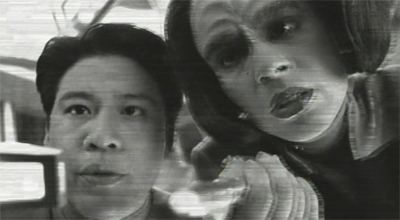


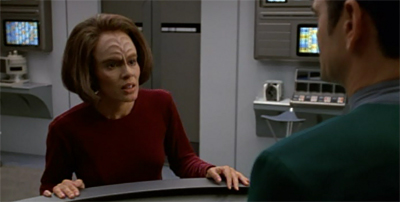

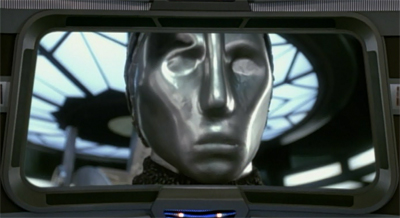
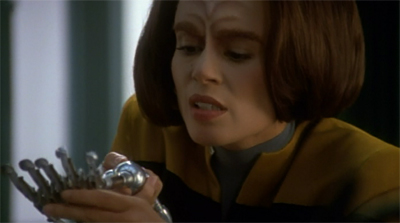







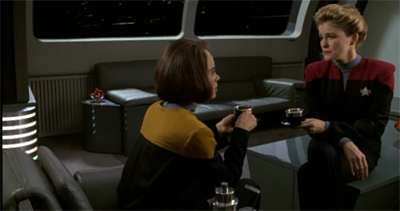

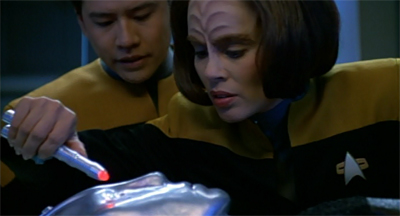







I always loved the design of the robots here. Very retro.
I agree that Voyager was less on the ball about current events than DS9 but I’m a little wary of falling victim to hindsight. As you said in your reviews of Homefront/Paradise Lost DS9 was eerily prescient… but they also devoted two seasons to refighting World War II in space. In some ways DS9 got very ‘lucky’ about the way things turned out in the current century (if ‘lucky’ is the right word.)
Yep, I think you’re right about DS9 being very lucky with regards to the shift in global politics.
Which at the same time means Voyager was unlucky. 😉 Hence my worry that we shouldn’t be somewhat wary of hindsight.
I think of the turn of the millennium speculative fiction shows Buffy the Vampire Slayer might have been the most prescient actually. Season 5 (2000 to 2001) was focused on a dark take on religious fanaticism where the villainess was served worshippers while the nominally ‘good’ – and explicitly crusader like – Knights of Byzantium turned out to be just as misguided. Again I think that was largely ‘luck’ but it is quite eerie. Season Six (2001 to 2002) also seems strangely prophetic about the listlessness and despair and anger of the Great Recession.
It has been years since I watched Buffy. I should really watch it again.
I rewatched it last year. Some bits look a little aged, the first season especially, and the monochrome nature of the cast, which though realistic for a small, middle class Californian town (a lot of inland California is every bit as white as the Vermont or New Hampshire) is much more noticable now than it was fifteen years ago. The show can be ridiculously heavy handed at times.
On the other hand the show as whole is essentially brilliant. Having one of the main cast discover her sexuality and have a long term girlfriend (who herself became one of the best loved characters in the show) was genuinely daring stuff very sensitively handled. The main cast performances range from good to great and Sarah Michelle Gellar is a lot more versatile than people give her credit for.
Rewatching it did make me think that Joss Whedon must have been bored out of his mind working on The Avengers films though – I like the movies but for a guy whose show focused on female characters, growing up and romantic relationships (especially of the run them through the emotional wringer kind) The Avengers must have seemed slim pickings.
I think Whedon does a good job with Avengers of making it Black Widow’s movie. Well, as much as feasible, anyway.
But Age of Ultron is one of the most glaring examples I’ve seen of a director/writer wanting to make one movie and the studio wanting to make another, with the result ending up as a weird disjointed compromise rather than a total hack job one way or the other. (“Hack” as in “machete-style”, not “hack” as in “souless.”)
How interesting would it have been if the robots had stuck around and Voyager became allies with them against the Kazon. It is just infuriating that Voyager refused to embrace consequences in any of their stories.
I think the worst element of voyager and mothering came later when seven of nine was given not one, but four kids to look after. Maybe even five since she ended being more of a mother to Naomi wildman than Naomi’s own mother was.
As much as I love the design of the robots, I’m not convinced that they’d make a good recurring foil. Then again “Kazon vs. Robots!” would have a deliciously pulpy edge to it.
In Maneuvers, we had Kazon floating in space, and in Prototype now we get robots. One week, space is a graveyard. The next it’s a junkyard.
Ha. That’s a good spot, actually.
“robots could be seen as an embodiment of the worst excesses of the American military-industrial complex.”
Sure, let’s go with that.
“‘Guys, this is Star Trek! You’re going to tell me we can’t do robots?”
They briefly did, in “The Offspring”. Which I quite liked, but which according to Memory Alpha a lot of writers had issue with.
“It is also hilarious that the show thinks the characters actually keep track of the shuttles they lose.”
Only when measuring each others’ penises!
You’ve made your point, I think. Star Trek at this phase in its life lacks the ability to make high drama work. Piller most certainly lacks the ability. This is the man who took inspiration for a 90-minute film from Rogaine.
Let’s put aside vague and unreal concepts such as serialization or drama: this is a very profitable franchise which has survived by delivering exactly what viewers expect. The grind of a 22-26 episode season doesn’t allow for any hiccups.
There are three disadvantages to using robots over actors in makeup. They look silly without CGI. If computer-generated, they are too costly to use. (See Species 8472.) If the robot lacks locomotion as the producers of Doctor Who know all too well, then suddenly you have to deal with dollies and tracks and other stuff getting in the way.
This isn’t art. It’s a business, and Jeri Taylor was completely within her right to give Piller the boot. Certainly they gave him way more leeway than he probably deserved. The guy was given two full seasons, and whiffed it.
Well, Piller was given a season and a half.
I suspect that is a large part of where the tension came from. Piller developed Voyager, and then left midway through the first year when Paramount snubbed him by refusing to let him write Generations. Piller then developed Legend, which flopped. As a result, Piller shuffled back to Voyager at the start of the second season, returning home to the writers’ room after appearing to skip out on them. In the meantime, Jeri Taylor had been running the room and everybody had tried to find their own voices. After missing that second half of the season, Piller then presumed to dictate how to do it “right.”
Which is one of the ironies of the second season of Voyager. Piller had ideas that were good in theory. More tension among the crew. Long-form storytelling. A recurring menace. Consequences. However, how Piller chose to put those ideas into action suggested he had no real understanding of the show. So while Taylor was certainly more conservative in outlook, her execution was a lot stronger. I am one of the few people who considers the Taylor years (seasons three and four) to be the highlight of the seven season run.
Janeway has a very ambivalent attitude towards the Prime Directive more than any of the other Star Trek captains. One week she’s sworn to uphold it, the next she throws it out the airlock when things get tough.
As well as losing Denise Crosby, Gates McFadden, another TNG castmember was let go at the end of S1 for completely different reasons. Then they brought in Diana Muldaur to fill the gap, which didn’t work out either when she didn’t get along with the cast or make any friends among the fanbase, and when she quit, McFadden came back through the revolving door Muldaur left through.
It seems Star Trek is still on the subject of b-movies, with DS9 also doing homages of their own in Little Green Men and Bond movies in Our Man Bashir. Of course, the ultimate b-movie homage still awaits in S5’s Bride of Chaotica!
Seska had the baby before Basics Pt II, but we first saw her son in Pt I. In Parturition, Tom and Neelix were marooned together on a planet and not a moon. Neelix’s programme was at first called A Briefing With Neelix, not Breakfast With Neelix, and later it becomes Good Morning Voyager before being dropped altogether. “Have you tried turning it off and back on again” made me laugh Darren because that very same day I had to do that with my iPad to get it to work (and it did!).
Good spot on the corrections!
And Bride of Chaotica was awesome!
Bride of Chaotica is one of the few truly great episodes of Voyager. Ah, the times Voyager actually is good….
The best part of this episode is it mentions Data. That’s all that’s good about it, literally.
I really like the robot designs. They are very fifties b-movie.
Yeah theyre good, but their personalities, uh not so much
If only Voyager and Enterprise embraced more readily pulp and were a series of Scorpion style episodes, I’d love the series, but alas, they are not…